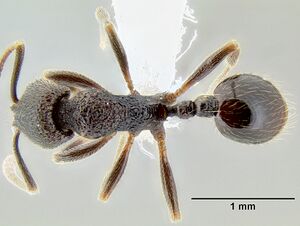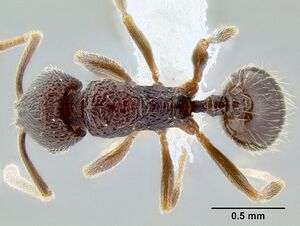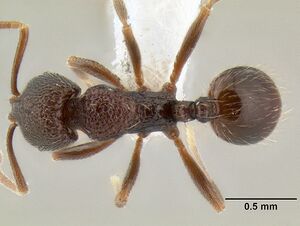Stenamma nonotch
| Stenamma nonotch | |
|---|---|

| |
| Scientific classification | |
| Kingdom: | Animalia |
| Phylum: | Arthropoda |
| Class: | Insecta |
| Order: | Hymenoptera |
| Family: | Formicidae |
| Subfamily: | Myrmicinae |
| Tribe: | Stenammini |
| Genus: | Stenamma |
| Species: | S. nonotch |
| Binomial name | |
| Stenamma nonotch Branstetter, 2013 | |
This species is known only from extracts of sifted leaf litter collected from the forest floor. It occupies a variety of wet forest habitat types (e.g. rainforest, mesophyll forest, 2° wet forest, Liquidambar forest, cloud forest, oak-pine forest) and occurs from near sea level to 2000 m. Dealate queens are commonly collected in samples, suggesting that the species may nest in the leaf litter microenvironment. (Branstetter 2013)
Identification
Branstetter (2013) - Integument mostly dark red-brown (almost black) to brown; small- to medium-sized species (see HL, ML, PrW below); anterior clypeal margin entire, or at most with a nearly imperceptible median notch (only visible from anterodorsal angle); basal margin of mandible straight; face densely sculptured, mostly rugoreticulate; dorsum of promesonotum rugoreticulate, or with many irregular rugulae; pilosity on gastral tergites indistinctly bilayered, forming a somewhat sparse layer of long suberect setae, and a very sparse layer of short decumbent setae; eye of small to moderate size (EL 0.09–0.11, REL 15–19), oval-shaped, with 4–7 ommatidia at greatest diameter; propodeal spines reduced to small triangular tubercles (PSL 0.08–0.14, PSI 1.1–1.4); frontal lobes of moderate width (FLD 0.14–0.19, FLI 25–29).
Stenamma nonotch forms a clade with Stenamma nanozoi, Stenamma sandinista and Stenamma schmidti and is very similar to these species (Branstetter unpublished data). However, it is the only species within the clade to have the anterior clypeal margin entire, and the basal margin of the mandible straight. This feature makes it easy to distinguish from its close relatives. Stenamma nonotch is also similar to Stenamma ignotum and Stenamma picopicucha, which both have a straight basal margin of the mandible. However, neither of these species have the anterior clypeal margin entire.
There is some variation among populations of S. nonotch, with workers differing in size, sculpture, and shape of the propodeal spines and petiolar node.
Keys including this Species
Distribution
Southern Mexico to Guatemala.
Latitudinal Distribution Pattern
Latitudinal Range: 19.5183333° to 16.09913°.
| North Temperate |
North Subtropical |
Tropical | South Subtropical |
South Temperate |
- Source: AntMaps
Distribution based on Regional Taxon Lists
Neotropical Region: Mexico (type locality).
Distribution based on AntMaps
Distribution based on AntWeb specimens
Check data from AntWeb
Countries Occupied
| Number of countries occupied by this species based on AntWiki Regional Taxon Lists. In general, fewer countries occupied indicates a narrower range, while more countries indicates a more widespread species. |

|
Estimated Abundance
| Relative abundance based on number of AntMaps records per species (this species within the purple bar). Fewer records (to the left) indicates a less abundant/encountered species while more records (to the right) indicates more abundant/encountered species. |

|
Biology
Castes
Males have yet to be collected.
Worker
Images from AntWeb
     
| |
| Holotype Stenamma nonotch. Worker. Specimen code casent0605789. Photographer Michael Branstetter, uploaded by Default Group. | Owned by USNM. |
      
| |
| Worker. Specimen code casent0604711. Photographer Michael Branstetter, uploaded by Default Group. | Owned by MGBPC. |
    
| |
| Worker. Specimen code casent0604848. Photographer Michael Branstetter, uploaded by Default Group. | Owned by MGBPC. |

| |
| Worker. Specimen code casent0603896. Photographer Michael Branstetter, uploaded by Default Group. | Owned by MGBPC. |
  
| |
| Worker. Specimen code casent0603920. Photographer Michael Branstetter, uploaded by Default Group. | Owned by MGBPC. |
Queen
Images from AntWeb
   
| |
| Queen (alate/dealate). Specimen code casent0605471. Photographer Michael Branstetter, uploaded by Default Group. | Owned by MGBPC. |
    
| |
| Queen (alate/dealate). Specimen code casent0605470. Photographer Michael Branstetter, uploaded by Default Group. | Owned by MGBPC. |
Nomenclature
The following information is derived from Barry Bolton's Online Catalogue of the Ants of the World.
- nonotch. Stenamma nonotch Branstetter, 2013: 201, figs. 131-133 (w.q.) MEXICO (Oaxaca, Chiapas, Veracruz).
- Type-material: holotype worker, 15 paratype workers, 4 paratype queens.
- Type-locality: holotype Mexico: Oaxaca, 3.4 km. SW Valle Nacional, 17.74320°N, 96.32729°W±40m., 370 m., 13.viii.2009, LSD329 (L. Sáenz); paratypes with same data.
- Type-depositories: USNM (holotype); CASC, CFSS, EAPZ, FMNH, ICNB, INBC, JTLC, LACM, MCZC, MGBC, MZSP, UCDC, UNAM, USNM, UVGC (paratypes).
- Distribution: Mexico.
Unless otherwise noted the text for the remainder of this section is reported from the publication that includes the original description.
Description
Worker
(17 measured) HL 0.57–0.76 (0.61), HW 0.51–0.68 (0.57), FLD 0.14–0.19 (0.15), PCW 0.03–0.07 (0.03), SL 0.46–0.64 (0.50), EL 0.09–0.11 (0.09), ACL 0.45–0.59 (0.49), ML 0.68–1.00 (0.78), PrW 0.36–0.49 (0.40), PSL 0.08–0.14 (0.11), SDL 0.06–0.11 (0.09), PL 0.26–0.40 (0.31), PH 0.16–0.23 (0.19), PW 0.14–0.19 (0.16), PPL 0.12–0.22 (0.15), PPH 0.13–0.21 (0.16), PPW 0.16–0.22 (0.18), MFL 0.50–0.72 (0.55), MTL 0.41–0.57 (0.45), CI 86–92 (92), SI 88–97 (89), REL 15–19 (16), FLI 25–29 (26), PSI 1.1–1.4 (1.3), MFI 93–104 (103), ACI1 65–69 (67), ACI2 92–99 (97).
Small- to medium-sized species; general body color dark red-brown (almost black) to brown, with appendages lighter, brown to yellow-brown toward extremities; setae golden; mandible with 6–7 teeth (usually 7), consisting of 3 larger, more distinct apical teeth, a basal tooth, and 2–3 smaller denticulate teeth, which are usually more worn, and sometimes indistinct; basal margin of mandible straight, without a basal notch or depression; mandible mostly smooth, except for scattered piligerous punctae, and a few basal striae; anterior clypeal margin entire, or at most with a nearly imperceptible median notch, only visible from anterodorsal view; median lobe of clypeus with faint longitudinal carinulae and some punctations, apex of lobe with a few short transverse carinulae, remainder of clypeus mostly smooth; posterior extension of clypeus between antennal insertions of moderate width (PCW 0.03–0.07), with sides subparallel to slightly hour-glass-shaped; frontal lobes of moderate width (FLD 0.14–0.19, FLI 25–29), not obscuring torular lobes in full-face view; head roughly oval-shaped (CI 86–92), posterior margin slightly depressed medially; eye of small to moderate size (EL 0.09–0.11, REL 15–19), oval-shaped, with 4–7 ommatidia at greatest diameter; face densely sculptured, mostly rugoreticulate, with a few longitudinal rugae along midline near frontal lobes; scape of moderate length (SI 88–97), almost reaching posterior margin of head when laid back; scape surface mostly smooth, with scattered piligerous punctae; flagellum with a distinct 4-segmented antennal club; most of mesosoma densely sculptured, dorsum of promesonotum rugoreticulate, or with irregular longitudinal rugae that only sometimes merge, side of pronotum variably rugulose-punctate, sometimes with a large patch of smooth cuticle, mesopleuron mostly punctate, with a few rugulae, side of propodeum rugulose-punctate, propodeal dorsum and upper half of declivity with a few transverse carinulae; promesonotum in profile low-domed, roughly symmetrical, sometimes dorsum slightly flattened; metanotal groove well-demarcated, moderate; propodeal spines tuberculate, often forming somewhat broad triangles (PSL 0.08–0.14, PSI 1.1–1.4); petiole appearing of moderate length (PL/HW 0.50–0.59), peduncle usually somewhat slender; petiolar node of moderate height to somewhat small (PH/PL 0.54–0.65), dorsum broadly rounded, and always pointing distinctly posteriad, area underneath node usually with a small concavity, or notch; postpetiole in profile subspherical to oblong, appearing slightly compressed anteroposteriorly; anterior faces of petiolar and postpetiolar nodes smooth, remaining surfaces mostly punctate, with a few rugulae on posterior half of postpetiole; gaster smooth, with scattered piligerous punctae; face with a mostly uniform layer of short decumbent setae; remainder of body dorsum with longer suberect setae; pilosity on gastral tergites indistinctly bilayered, with a relatively sparse layer of longer suberect to subdecumbent setae, and a sparser layer of decumbent to appressed setae; setae on scapes and legs mostly decumbent to appressed, with some suberect setae on femoral venters and coxae.
Queen
(5 measured) HL 0.61–0.76 (0.61), HW 0.56–0.70 (0.57), FLD 0.15–0.21 (0.16), PCW 0.04–0.08 (0.04), SL 0.50–0.64 (0.50), EL 0.15–0.20 (0.15), ACL 0.48–0.61 (0.49), ML 0.84–1.11 (0.86), PrW 0.49–0.63 (0.49), PSL 0.11–0.16 (0.14), SDL 0.09–0.12 (0.10), PL 0.33–0.44 (0.34), PH 0.19–0.25 (0.19), PW 0.17–0.22 (0.18), PPL 0.15–0.22 (0.18), PPH 0.19–0.25 (0.19), PPW 0.18–0.27 (0.21), MFL 0.55–0.73 (0.55), MTL 0.45–0.58 (0.45), CI 89–94 (94), SI 86–96 (86), REL 26–28 (26), FLI 27–31 (27), PSI 1.3–1.4 (1.4), MFI 93–104 (104), ACI1 64–67 (66), ACI2 94–98 (98).
Same as worker except for standard queen modifications and as follows: side of pronotum rugoreticulate to transversely rugose, center of pronotum transversely carinulate; mesoscutum mostly foveolate to longitudinally rugose, usually with some smooth cuticle along midline, foveolae when present piligerous; propodeum with transverse carinulae that wrap around surface; mesopleuron mostly smooth; pilosity on gastral tergites distinctly bilayered, with a sparse layer of longer suberect to subdecumbent setae and a dense layer of decumbent setae, lower layer usually almost pubescent, but sometimes less dense and longer; wing venation as shown in photo.
Type Material
Holotype worker. MÉXICO, Oaxaca: 4.3km SW Valle Nacional, 17.74320°N, 96.32729°W ±40m, 370m, 13 Aug 2009, disturbed tropical rainforest, ex sifted leaf litter (L. Sáenz, collection LSD329) USNM, specimen CASENT0605789. Paratypes: same data as holotype 1dq, 1w, CASC, CASENT0605782, CASENT0605788, 1w, EAPZ, CASENT0605790, 1w, ECOSCE, CASENT0623408, 1w, FMNH, CASENT0623409, 1w, ICN, CASENT0623410, 1w, INBC, CASENT0623411, 1w, JTLC, CASENT0623412, 1w, LACM, CASENT0623413, 1w, MGBPC, CASENT0623414, 1dq, 1w, MCZ, CASENT0605784, CASENT0623415, 1w, MZSP, CASENT0623416, 1w, UCDC, CASENT0623417, 1dq, 1w, UNAM, CASENT0605783, CASENT0623418, 1dq, 1w, USNM, CASENT0623407, CASENT0623419, 1w, UVGC, CASENT0623420.
Etymology
The specific epithet nonotch refers to the fact that this species has the anterior clypeal margin entire, without a median emargination.
References
- Branstetter, M. G. 2012. Origin and diversification of the cryptic ant genus Stenamma Westwood (Hymenoptera: Formicidae), inferred from multilocus molecular data, biogeography and natural history. Systematic Entomology 37:478-496. doi:10.1111/j.1365-3113.2012.00624.x
- Branstetter, M.G. 2013. Revision of the Middle American clade of the ant genus Stenamma Westwood (Hymenoptera, Formicidae, Myrmicinae). ZooKeys 295, 1–277. doi:10.3897/zookeys.295.4905
References based on Global Ant Biodiversity Informatics
- Ahuatzin D. A., E. J. Corro, A. Aguirre Jaimes, J. E. Valenzuela Gonzalez, R. Machado Feitosa, M. Cezar Ribeiro, J. Carlos Lopez Acosta, R. Coates, W. Dattilo. 2019. Forest cover drives leaf litter ant diversity in primary rainforest remnants within human-modified tropical landscapes. Biodiversity and Conservation 28(5): 1091-1107.
- Branstetter M.G. 2013. Revision of the Middle American clade of the ant genus Stenamma Westwood (Hymenoptera, Formicidae, Myrmicinae). ZooKeys 295: 1277
- Dattilo W. et al. 2019. MEXICO ANTS: incidence and abundance along the Nearctic-Neotropical interface. Ecology https://doi.org/10.1002/ecy.2944
- Longino J. et al. ADMAC project. Accessed on March 24th 2017 at https://sites.google.com/site/admacsite/



